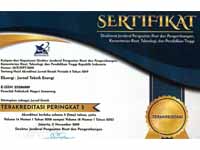KOMPARASI MASA JENIS ALIRAN MASUK TERHADAP NILAI TOTAL SUSPENDED SOLID (TSS) PADA OVERFLOW HYDROCYCLONE MENGGUNAKAN METODE COMPUTATIONAL FLUID DYNAMIC (CFD) PADA PT. PLN (PERSERO) PEMBANGKITAN TANJUNG JATI B UNIT 3 DAN 4
DOI:
https://doi.org/10.32497/eksergi.v9i3.186Abstract
PT. PLN (Persero) Pembangkitan Tanjung Jati B Unit 3 Dan 4 menangani air limpasan batubara dilakukan dengan mengendapkan pada coal runoff basin, dan mengalirkan ke WWTP untuk mengkondisikan air limpasan batubara sesuai peraturan KLH sebelum dibuang ke laut. Air limpasan batubara parameter yang tidak memenuhi standart KLH adalah nilai total suspended solid (TSS), nilainya diatas 100 mg/l sebab inilah ketidak efektifan air limpasan batubara diproses pada WWTP, karena hanya untuk menurunkan nilai TSS. Terdapat gagasan untuk mengganti proses pada WWTP dengan hydrocyclone. Penggunaan hydrocyclone dilapangan terlebih dahulu dilakukan pembuktian secara ilmiah melalui simulasi dengan metode computational fluid dynamic (CFD). Penilitian bertujuan untuk membandingkan pengaruh jumlah padatan berupa lumpur batubara didalam air limpasan batubara terhadap kinerja hydrocyclone. Metode penelitian menggunakan CFD, ada 3 tahapan, pertama pembuatan model 3 dimensi, kedua proses pencacahan, dan ketiga proses simulasi. Dari hasil simulasi dengan nilai masa jenis 1000.23 kg/m3 nilai efisiensi 95,28 % dan pada nilai masa jenis 1002,38 kg/m3 nilai efisiensi 99,95 %. Hasil simulasi hydrocyclone efisiensi terbaik pada nilai masa jenis 1002,38 kg/m3 dengan nilai efisiensi 99,95 %. Dapat disimpulkan hydrocyclone mampu memisahkan padatan berupa lumpur batubara dan air didalam air limpasan batubara dengan range nilai masa jenis 1000.23 kg/m3 sampai 1002,38 kg/m3Kata kunci: Hydrocyclone, computational fluid dynamic (CFD), TSS
Downloads
Published
Issue
Section
License
Authors who publish with this journal agree to the following terms:Authors retain copyright and grant the journal right of first publication with the work simultaneously licensed under a Creative Commons Attribution License that allows others to share the work with an acknowledgement of the work's authorship and initial publication in this journal.
Authors are able to enter into separate, additional contractual arrangements for the non-exclusive distribution of the journal's published version of the work (e.g., post it to an institutional repository or publish it in a book), with an acknowledgement of its initial publication in this journal.
Authors are permitted and encouraged to post their work online (e.g., in institutional repositories or on their website) prior to and during the submission process, as it can lead to productive exchanges, as well as earlier and greater citation of published work (See The Effect of Open Access).







